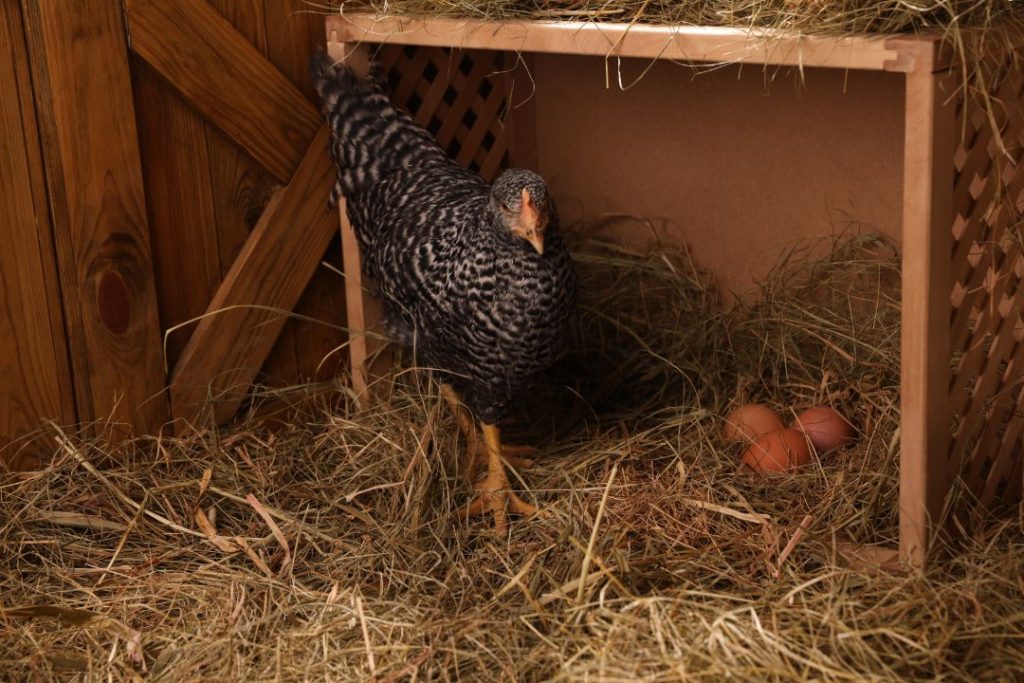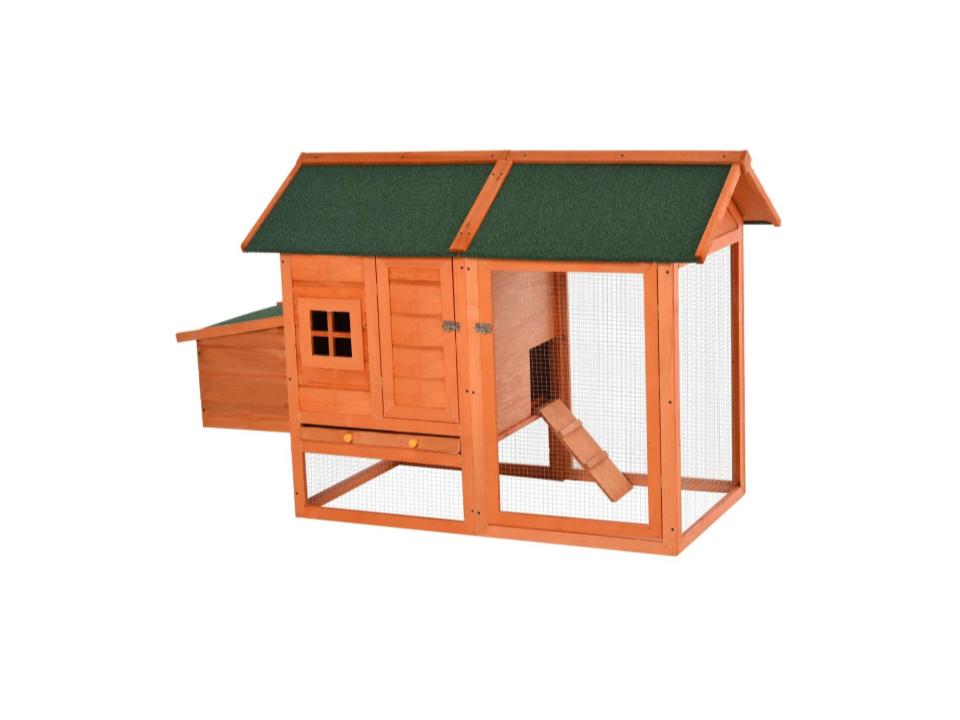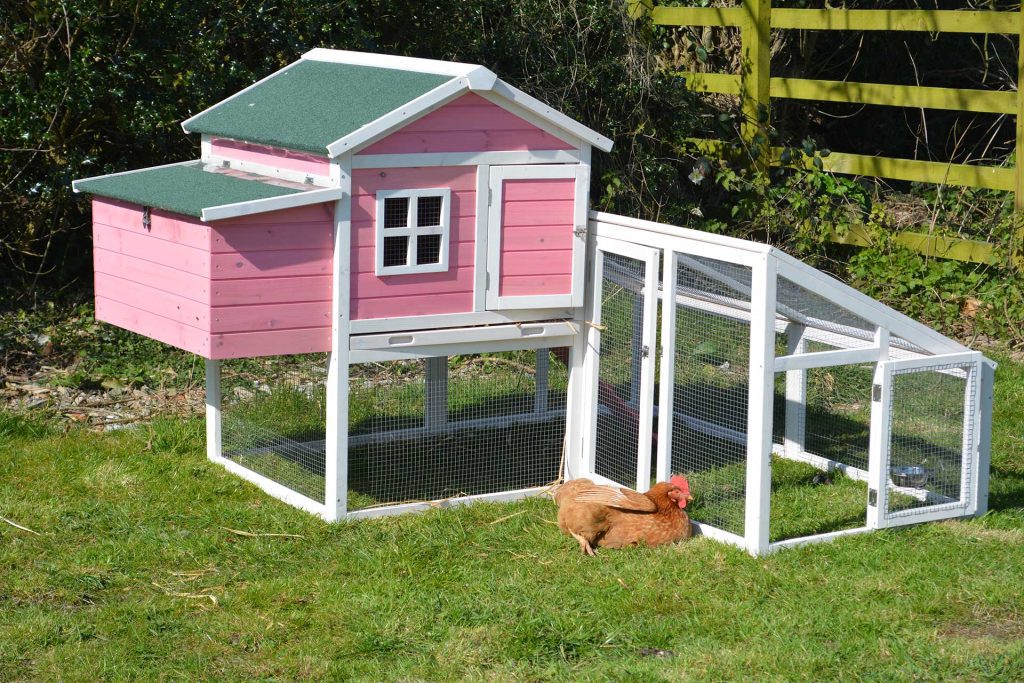Raising chickens, especially the popular Rhode Island Reds, is a rewarding experience. But one question that often arises is: What size should chicken nesting boxes be? The size of nesting boxes for chickens plays a pivotal role in ensuring the comfort and productivity of your flock.
The size of nesting boxes for chickens is crucial for their well-being and productivity. For breeds like the Rhode Island Reds, a 12x12x12 inch box usually hits the mark.
However, consider factors like your chicken’s age, breed, and the number of hens sharing the box. With the right nesting box size, you’re on your way to a happy, healthy, and productive flock.
This comprehensive guide will explore the ideal dimensions, factors to consider, and the benefits of getting it right. So, let’s start:
Why Does Nesting Box Size Matters?
The size of nesting boxes for chickens plays a pivotal role in poultry keeping. Ensuring comfort, egg safety, and cleanliness are essential for a thriving flock and a steady supply of fresh, uncontaminated eggs.
Proper research and understanding of the needs of your specific chicken breed can go a long way in ensuring you provide the best environment for them.
Comfort for Your Chickens
Chickens cherish their privacy during laying. A snug nesting box offers them this solace. Nesting boxes that are too tight can stress hens. Conversely, oversized boxes can make hens feel vulnerable.
Comfort directly influences a hen’s laying frequency. A relaxed hen will lay more consistently. Consistent laying means a steady supply of fresh eggs. Always prioritize the comfort of your flock. Their well-being directly impacts their productivity.
Egg Safety
Eggs are delicate treasures. A nesting box’s dimensions are crucial to egg safety. Hens need space to lay without pressure. Pressure on the hen or egg can cause cracks. Cracked eggs can lead to wasted produce.
Moreover, bacteria can enter through these cracks. Consuming such eggs can pose health risks. A spacious box also prevents hens from stepping on eggs. Stepped-on eggs can break, causing a mess. Broken eggs can attract pests and rodents.
Pests can introduce diseases to your flock. Proper nesting box dimensions minimize these risks. Safety should always be a top priority. Healthy hens and safe eggs benefit everyone.
Cleanliness
Cleanliness is paramount in poultry keeping. A clean environment promotes healthy hens. Nesting boxes that are too small can cause problems. Hens might accidentally soil the eggs in tight spaces. Soiled eggs can harbor harmful bacteria. Consumption of such eggs can lead to illnesses.
Oversized boxes can also pose challenges. Hens might scatter their bedding, leading to uneven surfaces. Uneven surfaces can cause eggs to roll and break. A well-sized box ensures even bedding distribution. Even bedding means eggs remain clean and safe. Regular cleaning of the boxes is essential.
However, the right box size can reduce cleaning frequency. A clean nesting environment ensures fresh, uncontaminated eggs. Prioritizing cleanliness benefits both the hens and those consuming the eggs.
What Are the Average Size of Nesting Boxes for Chickens?
Dimensions influence a hen’s laying behavior. Hens seek privacy and security during this time. A well-sized box offers both. Nesting boxes that are too tight can deter laying. Hens might seek alternative spots, like the ground. Ground-laid eggs risk contamination and damage.
Conversely, oversized boxes can make hens feel exposed. Exposure can stress hens, leading to inconsistent laying. Consistency in laying ensures a steady egg supply. A steady egg supply benefits both the poultry keeper and consumers.
Always prioritize the needs of the specific breed. Their comfort directly impacts productivity. Now let’s learn about the average size of nesting boxes for chickens:
Standard Dimensions
Nesting boxes serve as a sanctuary for hens. Most medium-sized chicken breeds prefer 12x12x12 inches. Such dimensions offer ample space for laying. Hens can turn, adjust, and settle comfortably. Adequate space ensures hens feel secure.
Security during laying boosts egg production. Medium-sized breeds include the Sussex and Plymouth Rock. Both breeds find 12x12x12 inches ideal for laying. A nesting box’s height is crucial, too.
Twelve inches in height prevents hens from scratching out bedding. Bedding remains even, ensuring eggs stay clean. Width and depth provide enough space for laying. Remember, comfort is paramount for consistent laying.
Catering to Larger Breeds
Larger chicken breeds need more space. Breeds like Jersey Giants or Brahmas are examples. Their larger size demands bigger nesting boxes. Typically, 14x14x14 inches suits them best. Adequate space prevents these breeds from feeling cramped.
Cramped spaces can stress hens, affecting laying. Stress can also lead to health issues. A spacious nesting box promotes relaxation. Relaxed hens lay better and more frequently. Larger breeds also have bigger eggs.
Bigger eggs need more space to prevent breakage. Breakage can attract pests and cause diseases. Always consider the breed’s size when choosing a box. Adjusting dimensions for larger breeds ensures their well-being.
What Factors Influence the Best Size for Chicken Nesting Boxes?
Choosing the right nesting box size is an art and science. Factors like breed, age, and number play pivotal roles. Beyond these, understanding the unique needs of each flock is essential. Regular observation and flexibility in design ensure the flock’s happiness. A happy flock means consistent egg production and a satisfied poultry keeper.
However, the following factors influence the best size of your chicken nesting boxes:
Breed’s Role in Determining Size
Different chicken breeds have varied sizes and preferences. Rhode Island Reds, medium in stature, prefer specific dimensions. In contrast, larger breeds like Jersey Giants require more space. The average size of a chicken nesting box greatly depends on the breed’s size.
Smaller breeds, such as Bantams, need less room. Understanding each breed’s unique requirements is essential. Tailoring the nesting box size to the breed ensures comfort. Comfort, in turn, promotes consistent egg-laying.
Age and Its Impact on Size Preference
Chickens, like all creatures, grow over time. Chicks and pullets have different space needs than mature hens. Younger hens, still growing, might find smaller boxes adequate. As they mature, their space requirements change.
Adjusting box sizes as hens age is crucial. An appropriately sized box for a pullet might feel cramped for an adult. Continual observation helps in making timely adjustments. Meeting the changing needs of hens ensures their well-being.
Number of Chickens per Box
Not all hens get individual nesting boxes. Sometimes, multiple hens share a single box. Sharing can be harmonious if the box size is right. A box meant for one might feel crowded for two. Crowded boxes can lead to stress and disputes.
Disputes can deter your hens from laying in the boxes. More hens sharing a box necessitate larger dimensions. Space should allow all hens to perform natural behaviors. Turning, settling, and lying are all essential. Adequate space for each hen promotes peace and productivity.
Flexibility
No one-size-fits-all approach works for nesting boxes. Flexibility in design and size is key. Regularly observing the flock provides insights. Adjustments ensure that your flock remains content. A content flock lays consistently, benefiting the poultry keeper.
Other Influential Factors to Consider
- Climate and Weather: A slightly snugger box might provide warmth in colder regions. Warmer climates require well-ventilated and roomier boxes.
- Laying Patterns: Some hens lay daily, while others might lay less frequently. Frequent layers would appreciate more space.
- Health and Physical Condition: Hens with health issues or physical challenges might have unique needs. Accommodating their conditions ensures they remain comfortable.
What Are the Benefits of Getting the Right Size Nesting Boxes?
The dimensions of a nesting box seem like a minor detail. Yet, its impact is profound. From boosting egg production to ensuring hen well-being, the benefits are manifold. Investing time in choosing the right size pays off.
It pays off in productivity, health, and overall satisfaction. For those passionate about poultry, such details matter. They matter for the flock’s well-being and the keeper’s joy.
Unlocking Higher Egg Production
A hen’s comfort directly influences her laying frequency. Nesting boxes tailored to a hen’s size promote relaxation. Relaxed hens lay eggs more consistently. Consistency ensures a steady supply of fresh eggs.
A steady egg supply delights both poultry keepers and consumers. In essence, comfort translates to productivity. Productivity is the ultimate goal for many poultry enthusiasts.
Promoting Chicken Well-being
Stress is a silent adversary for hens. Cramped or oversized nesting boxes can induce stress. Stressful environments can lead to various health issues. Health issues might include reduced immunity or feather pecking.
A well-sized nesting box offers sanctuary. In this sanctuary, your hens feel secure and protected. Security and protection foster a sense of well-being. Healthy hens are often a result of stress-free environments. Their vibrant feathers, active behaviors, and consistent lying are evident. Prioritizing their well-being ensures longevity and productivity.
Simplifying the Egg Collection Process
Collecting eggs should be a smooth process. A nesting box of the right size aids in this. Eggs remain centralized in well-sized boxes. Centralized eggs mean fewer chances of them rolling or getting hidden. Fewer roll-aways reduce the risk of breakage.
Broken eggs can attract pests and cause a mess. Pests can introduce diseases, affecting the flock’s health. A smooth collection process saves time. Time-saving means poultry keepers can focus on other essential tasks. In essence, the right box size streamlines daily routines.
Happy Hens and Happy Keepers
The right nesting box size offers a ripple effect. The immediate benefits are evident in egg production and hen health. But the advantages extend beyond these. Poultry keepers experience ease in their routines. Simplified routines mean poultry keeping remains a joy, not a chore.
Happy hens lay better, act healthier, and live longer. Their contentment is reflected in their behaviors. Observing a content flock brings joy to poultry enthusiasts. In essence, the right nesting box size fosters happiness. Happiness for the hens and satisfaction for the keepers.
Additional Advantages of Properly Sized Nesting Boxes
- Cleanliness: Properly sized boxes ensure even bedding distribution. Even bedding keeps eggs clean. Clean eggs reduce contamination risks. Reduced contamination ensures safer consumption.
- Durability: Hens are less likely to damage well-sized boxes. Less damage means longer-lasting nesting boxes. Longer-lasting boxes save poultry keeper’s money in the long run.
- Harmony in the Flock: Hens feel less territorial in well-sized boxes. Reduced territorial behaviors mean fewer disputes. Fewer disputes ensure a harmonious environment.
- Optimal Utilization of Space: Tailored nesting boxes optimize coop space. Optimized space allows for better coop design. Better design can accommodate more amenities for the flock.
- Attractiveness for Laying: Hens prefer nesting boxes that suit their size. Such boxes attract them for laying. Attractiveness ensures hens lay in designated areas. Designated laying simplifies egg collection further.
What Are The Common Mistakes in Choosing Nesting Box Sizes?
You must choose the right nesting box size for your flock to ensure their health, comfort, and productivity. However, many poultry keepers, especially beginners, often need help selecting the size of their nesting boxes.
So now we will guide you to select the size of nesting boxes for chickens and to avoid common mistakes.
1. Going Too Small
Opting for too-small nesting boxes is one of the most frequent mistakes chicken keepers make. Too cramped chicken boxes can lead to numerous problems. Hens require a comfortable space to lay their eggs. In a restricted space, they might feel stressed, which can adversely affect their laying patterns.
Moreover, a small nesting box increases the risk of eggs getting damaged. When hens don’t have enough room to move, they might accidentally step on and break their eggs.
Additionally, a confined space can lead to more frequent cleaning as droppings accumulate faster. Over time, hens might seek alternative laying spots, leading to a scattered and inconsistent egg collection.
2. Choosing One Size for All
Every poultry keeper knows that not all chickens are the same. Different breeds come with different sizes and needs. Mismatch in nesting box sizes can affect egg production rates. Hens might become reluctant to use a box that feels wrong, leading them to lay eggs in random locations.
Furthermore, when the box doesn’t cater to the hen’s size, there’s a higher chance of egg breakage and reduced egg quality. You must understand each breed’s specific needs in your flock and customize the nesting boxes accordingly.
3. Not Considering Growth
Chickens aren’t always going to be the cute little chicks you started with; they grow, and they grow fast. A common oversight needs to account for this growth when choosing nesting boxes. What works for a chick will undoubtedly be unsuitable for a mature hen.
As chickens mature, their requirements change. They’ll need more space for comfort and to ensure they can lay their eggs without any hindrance. If you don’t consider this growth, you’ll frequently replace or adjust the nesting boxes, which can be both time-consuming and costly.
Moreover, constantly changing their environment can stress the hens, leading to erratic laying patterns.
Tips for Setting Up Your Nesting Boxes
Setting up nesting boxes requires careful consideration. From location to material, every detail matters. These details influence the flock’s laying behaviors. Prioritizing their comfort and safety ensures productivity.
A well-set nesting box benefits both hens and poultry keepers. It fosters a harmonious environment where both thrive.
Choosing the Right Location
Nesting boxes thrive in serene environments. Hens seek privacy during their laying process. Quiet spots encourage consistent lying. Low-light areas offer added comfort. Bright lights can make hens feel exposed. An exposed feeling can deter them from using the boxes.
Always prioritize a location that mimics natural laying environments. Such locations ensure your hens feel secure and protected.
Selecting the Ideal Material
Wood remains a classic choice for nesting boxes. Its natural insulation offers warmth during colder months. Additionally, wood provides a rustic aesthetic to coops.
However, modern poultry keepers have more options. Metal boxes, when insulated, serve as durable alternatives. They resist pests and are easy to clean. Plastic boxes, too, offer benefits. Lightweight and resistant to rot, they’re becoming increasingly popular.
Regardless of material, insulation is key. Insulated boxes maintain a consistent temperature. Consistent temperatures ensure hens remain comfortable year-round.
Opting for the Best Bedding
Bedding plays a dual role: comfort and cleanliness. Straw stands out as a traditional bedding choice. Its thick strands provide cushioning for eggs. Cushioning reduces the risk of breakage. Wood shavings, another popular choice, offer similar benefits.
They’re absorbent, ensuring the box remains dry. A dry environment reduces the risk of bacterial growth. Bacteria can contaminate eggs, posing health risks. Both straw and wood shavings are easy to replace.
Regular replacement ensures the nesting box remains fresh. Fresh environments attract hens, promoting consistent laying.
Regular Maintenance is Key
Setting up the nesting box is just the beginning. Regular maintenance ensures its longevity. Check for signs of wear and tear. Replace damaged parts promptly. Clean the boxes regularly to prevent diseases.
Diseases can affect your flock’s overall health. Replace bedding whenever it appears soiled. Fresh bedding ensures hens remain attracted to the boxes. An attractive nesting environment promotes consistent laying.
Additional Considerations for Nesting Box Setup
- Accessibility: Ensure boxes are easily accessible. Hens should enter and exit without difficulty. Easy access also simplifies egg collection.
- Ventilation: Proper airflow prevents moisture buildup. Moisture can lead to mold growth. Mold poses health risks to hens.
- Size: While material and location matter, size remains crucial. Tailor the size to the breed’s specific needs.
- Safety: Ensure the boxes are secure. Predators should not access them. Secure boxes protect both hens and their eggs.
Frequently Asked Questions
What size do chicken nesting boxes need to be for bantams?
Bantams are smaller, so 10x10x10 inches should suffice. Such dimensions provide them with ample space to lay comfortably. While they’re smaller than standard hens, their comfort remains paramount. A well-sized box ensures they lay consistently and remain stress-free.
How often should I clean the boxes?
Regular cleaning promotes a healthy laying environment. Aim to clean the boxes at least once a week. However, daily checks are essential. Inspect the bedding for signs of soiling. Soiled bedding can harbor bacteria, posing health risks.
Replacing soiled bedding promptly ensures the box remains fresh. A fresh environment attracts hens and promotes consistent laying.
Can multiple hens share a box?
Sharing is common among hens, especially in larger flocks. However, space considerations are crucial. A box meant for one hen might feel cramped for two. Cramped spaces can lead to disputes. Disputes can deter hens from using the boxes.
If sharing is the norm, opt for spacious boxes. Spacious boxes ensure all hens can perform natural behaviors. Turning, settling, and laying are all essential. Adequate space for each hen promotes harmony and productivity.
Wrapping Up
In poultry management, every detail, no matter how small, can significantly impact your flock’s health and productivity. Among these details, the size of nesting boxes for chickens stands out as a critical factor.
The right dimensions ensure that your hens have a comfortable space to lay their eggs. The correct size of nesting box for chickens play a pivotal role in their overall health, stress levels, and laying consistency. Poultry keepers can create an environment that minimizes disruptions and maximizes egg production by understanding and prioritizing the specific size requirements of different breeds.
Furthermore, a well-sized nesting box reduces the chances of egg breakage, promotes cleanliness, and can even deter potential predators. In essence, by paying attention to the size of nesting boxes, you can ensure a harmonious coop, leading to happier hens and a more bountiful yield.



